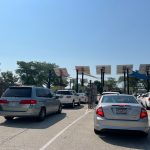Should Milwaukee Stop The Hop?
Alderman proposes this, but suspending the service might cost more than it saves.
The City of Milwaukee is facing a budget crisis and a federal grant that funds startup operations of The Hop, Milwaukee’s streetcar system, will soon run out.
The city will need to allocate $3.2 million from the city’s parking-centric transportation fund to operate the system in 2021, the first time it has needed to tap its own revenues to operate the system.
So why not simply suspend the service until the crisis is over?
But Department of Public Works Commissioner Jeff Polenske said it’s not that simple. Halting operations would trigger a bill totaling tens of millions of dollars.
“When we decided to make this improvement we did it in significant part with federal money and as part of that we entered into kind of a contractual agreement or project agreement with the federal government,” said Polenske. “We do have an obligation to operate this for the life of the improvement.”
The federal government contributed $69.1 million to the $128.1 million system, including the partially-completed lakefront line.
“I have had written conversations with the Federal Transit Administration and they certainly have concurred that we do have a legal obligation as part of that contractual agreement to continue to operate,” said Polenske. The commissioner said the contract includes benchmarks for frequency and hours of service.
But even if the city could halt operations temporarily, Polenske said there would be costs to that. “There really isn’t a shutting down option. There still is this underlying operation that needs to take place to maintain the infrastructure and maintain the vehicles,” he said. “There is also a cost of having to retrain the workforce that operates the system.”
Cincinnati took the highly unusual step with its system, similar in length to Milwaukee’s, of operating with no passengers from late March through early September instead of suspending operations. The move avoided restart costs estimated to run from $325,000 to $1 million.
The commissioner said the service has become an “essential” part of the city’s transportation network. “Well it is a single route, we are part of a system,” said Polenske. MCTS rerouted routes 15 and 30 as part of the system’s construction to avoid duplicating service.
Murphy, who voted for the system, said he would be submitting a formal letter to DPW asking for a written opinion.
Ald. Scott Spiker, who hasn’t been in office long enough to vote on the system, said he was concerned about the costs. “One might think people can be reasoned with in these extraordinary times,” said the far southside alderman.
Polenske said the streetcar did receive federal aid via an allocation to transit systems through the CARES Act and he anticipated a second bailout would also include The Hop. The Milwaukee area received approximately $62 million from a formula-based $25 billion transit bailout. Over $50 million went to MCTS.
The Hop is budgeted to cost $4.5 million in 2021 according to Mayor Tom Barrett‘s budget proposal. A total of $1.2 million would come from Potawatomi Hotel & Casino’s sponsorship, a delayed-but-not-canceled kiosk system and other sponsorship deals. A city reports says $110,000 would come from a Section 5307 FTA grant.
The 2.1-mile system is scheduled to be free to ride in 2021.
There is a precedent for the federal government seeking its funds back. The Downtown Transit Center, the now-demolished bus facility at 909 E. Michigan St., had not reached the end of its life when it was sold. In order to avoid having to repay a couple million dollars in unamortized costs to the federal government, a transit concourse for The Hop and East-West bus rapid transit line will be constructed in the base of The Couture tower.
If you think stories like this are important, become a member of Urban Milwaukee and help support real, independent journalism. Plus you get some cool added benefits.
More about the 2021 Milwaukee Budget
- City Hall: Council Delays on Federal COPS Grant - Jeramey Jannene - Nov 25th, 2020
- City Hall: Council Overrides One of Two Barrett Vetos - Jeramey Jannene - Nov 24th, 2020
- City Hall: Barrett Issues Two Budget Vetoes - Jeramey Jannene - Nov 18th, 2020
- City Hall: $1.6 Billion Adopted Budget Raises Fees, Cuts Police - Jeramey Jannene - Nov 6th, 2020
- Transportation: Budget Amendment Would Move Milwaukee Towards “Vision Zero” - Jeramey Jannene - Oct 30th, 2020
- City Hall: Committee Approves Over 20 Amendments To Milwaukee Budget - Jeramey Jannene - Oct 30th, 2020
- City Hall: Almost Half of Budget Amendments Are Policy Footnotes - Jeramey Jannene - Oct 29th, 2020
- City Hall: Community Groups Propose Changes - Jeramey Jannene - Oct 19th, 2020
- City Hall: City Could Lose 30 More Police Officers - Jeramey Jannene - Oct 19th, 2020
- Transportation: Should Milwaukee Stop The Hop? - Jeramey Jannene - Oct 13th, 2020
Read more about 2021 Milwaukee Budget here
More about the Milwaukee Streetcar
For more project details, including the project timeline, financing, route and possible extensions, see our extensive past coverage.
- Alderman, State Allies Seek Federal Help to Kill the Streetcar - Jeramey Jannene - Oct 28th, 2025
- Streetcar Service Suspended Following Truck Crash - Jeramey Jannene - Oct 21st, 2025
- One Alderman’s Quest To Defund The Streetcar - Jeramey Jannene - Oct 18th, 2025
- Another Streetcar Collision - Jeramey Jannene - Jun 27th, 2025
- Streetcar Hit By Apparent Red Light Runner - Jeramey Jannene - Jun 16th, 2025
- Streetcar Will Run On Consolidated Route During Summerfest - Jeramey Jannene - Jun 11th, 2025
- City Hall: Milwaukee Must Replace Failing Streetcar Switches - Jeramey Jannene - Feb 24th, 2025
- Streetcar Confronts Limited Funding, Operations Challenges - Evan Casey - Jan 22nd, 2025
- Council Kills Streetcar’s ‘Festivals Line’ - Jeramey Jannene - Jul 31st, 2024
- Streetcar Will Use Festivals-Oriented Route Through Summer - Jeramey Jannene - Jul 9th, 2024
Read more about Milwaukee Streetcar here
Political Contributions Tracker
Displaying political contributions between people mentioned in this story. Learn more.
- December 31, 2020 - Tom Barrett received $500 from Jeff Polenske
- December 2, 2018 - Tom Barrett received $400 from Jeff Polenske
- May 25, 2017 - Tom Barrett received $400 from Jeff Polenske
- February 1, 2016 - Tom Barrett received $400 from Jeff Polenske
Transportation
-
MCTS Adds 28 New Buses
 Jul 13th, 2024 by Graham Kilmer
Jul 13th, 2024 by Graham Kilmer
-
MCTS Designing New Bus Shelters
 Jul 10th, 2024 by Graham Kilmer
Jul 10th, 2024 by Graham Kilmer
-
MCTS Updates RNC Bus Detours To Better Serve Downtown, Riders
 Jul 9th, 2024 by Jeramey Jannene
Jul 9th, 2024 by Jeramey Jannene






















No, Milwaukee should not stop The Hop. A suspension of service, besides being financially precarious in the short run, would damage the long run power of The Hop to motivate growth, jobs, and tax revenue supporting all parts of the city for services. The Hop has demonstrated, in its nearly two years of operation, an ability to serve as transit, support development, and a build an emissions-free, walkable-urbanism-oriented, accessible, permanent transportation future for the city–all on a small starter route. Clearly, the pandemic has affected business and transit worldwide. The downturn in Hop ridership is due to the pandemic, but ridership has been recovering as destinations open. The Hop’s service can be a key part of the recovery period by providing connections and motivation for further development.
Simply put, The Hop has built up momentum, and it would be a waste of money to incur the costs of suspending it now out of an attempt, which may likely fail, to save money. Most seriously, it would damage the long-term benefits and momentum which has been built up and for which investments have already been made. Milwaukee’s future growth will stagnate if investments are not made in urban-oriented transportation.
There is no doubt revenue sources should be explored and expanded, such as from transportation spending at all levels of government and increased advertising revenue that might be gained by small-scale sponsorships on the vehicles, onboard video screens, and Web site.
I see the streetcar as key to moving Milwaukee forward. I see this in the construction along the route, and the connections the streetcar makes among walkable urban places. The emissions-free nature of the streetcar, its accessibility through large doors, its smooth ride, its predictable-path tracks, its permanence as infrastructure, its hybrid battery and overhead-wire energy system, its ability to connect walksheds around destinations, its strength in supporting transit-oriented development including affordable housing, its ability to alleviate the need for automobile storage at destinations–all contribute to its place-building and city-building strengths. Moreover, these qualities are non-existent or weak in current bus-based transit systems. The abilities of streetcars have been proven in hundreds of streetcar systems throughout the world for more than a century operating in a range of climates and city sizes. In fact, Milwaukee’s early transportation network included streetcars–first horse-drawn, then electric–because they connected the walkable urbanism of that time, and it is this walkable urbanism’s legacy that is truly one of the most distinctive strengths of Milwaukee to attract growth and development.
I’m on the Hop’s route, exactly, with a loading platform right outside my window. It’s virtually empty most of the time and of precisely zero benefit for me. I hear most people saying, when they even bother to talk about it, it’s a silly idea for the $$ it costs. I fail to see how it affects all those things that its proponents are claiming. A significant outcome is cars backed up and idling at the stop light, not for seconds but for what seems like minutes, waiting for a train to move on, or for another one to creep through the intersection while cars sit and spew emissions. This did NOT happen when we had no train to clog things up and stop sign instead of timed stop lights that seem always to be on red or yellow. Apparently, we are committed to the Federal Govt to keep it going, regardless. What we don’t need is more property taxpayer money extracted from those of us who watch it circling around like a “ghost ship”. You take money from Washington DC at your own peril because the strings are always attached; sooner or later they will trip you up.
I am very pro public transit and I think the above comment has it right. It is a glorified bus (so richer ppl feel comfortable taking it). The fact that it shared traffic with cars already doomed it. Milwaukee already has one of the most extensive bus systems in the country. Work on getting electric buses and improved routes and market it to attract more ridership and reduce car traffic.